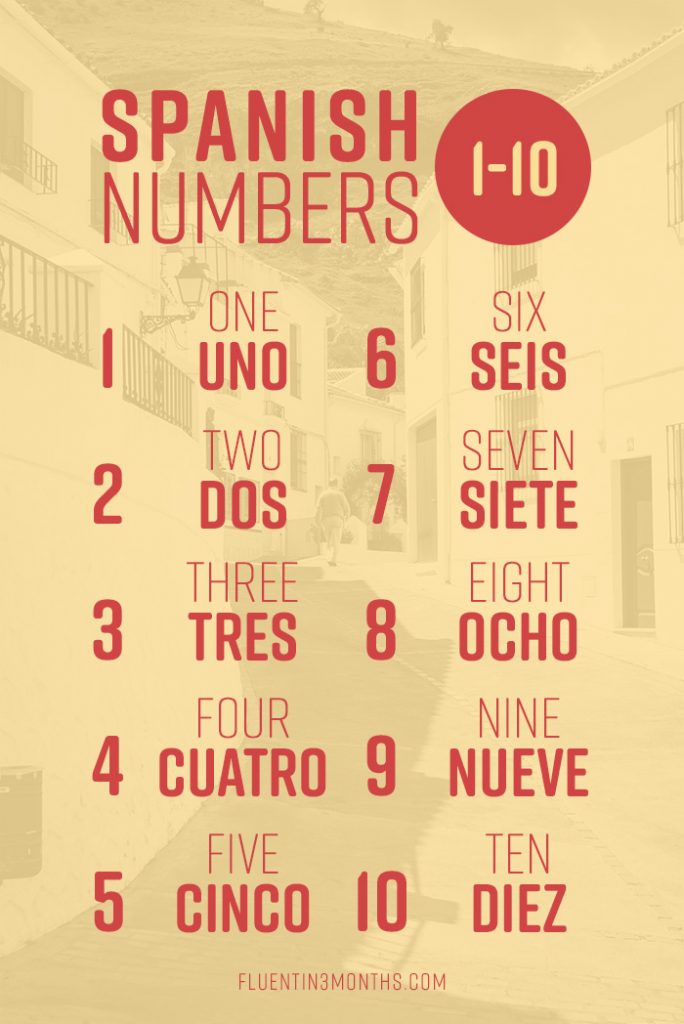How To Say One Thousand In Spanish
Spanish Numbers: How to Count from one – one,000+ in Spanish
Would you like to know about Castilian numbers, and how to count from ane-100 in Castilian?
In this commodity, I share everything you need to know most numbers in Castilian. I cover what the Castilian numbers are, examples of how to use them, and then much more than.
- Spanish for Numbers 1-10
- i – 100 Spanish Numbers
- Counting Spanish Numbers one – g+
- Billions and Trillions in Spanish (They're Not What You Recall)
- How Do You Pronounce Castilian Numbers?
- Castilian for "One": Un, Uno, or Una?
- Spanish for 100: Cien or Ciento?
- Breaking Upwardly Castilian Numbers: Dots or Commas?
- How to Say "…and a Half" in Spanish
- Ordinal Numbers in Castilian
- Examples of How to Use Spanish Numbers
- Numbers in Spanish: How Do You lot Acquire Them?
In case y'all were wondering how to say "numbers" in Castilian, it's números. The give-and-take for "number" in Spanish is número.
So, let'due south learn some números, starting with Spanish cardinal numbers!
Spanish for Numbers i-10
Let'due south start with the nuts. Here are the central numbers in Spanish from ane-10:
1 – uno
2 – dos
3 – tres
4 – cuatro
5 – cinco
6 – seis
vii – siete
8 – ocho
9 – nueve
ten – diez

ane – 100 Spanish Numbers
Now for the Spanish numbers ane to 100. After you lot've read these, I'll explain some tricks for remembering them.
| 1 uno | 2 dos | iii tres | 4 cuatro | v cinco |
| 6 seis | seven siete | 8 ocho | 9 nueve | ten diez |
| 11 one time | 12 doce | thirteen trece | 14 catorce | 15 quince |
| sixteen dieciséis | 17 diecisiete | xviii dieciocho | 19 diecinueve | 20 veinte |
| 21 veintiuno | 22 veintidós | 23 veintitrés | 24 veinticuatro | 25 veinticinco |
| 26 veintiséis | 27 veintisiete | 28 veintiocho | 29 veintinueve | xxx treinta |
| 31 treinta y uno | 32 treinta y dos | 33 treinta y tres | 34 treinta y cuatro | 35 treinta y cinco |
| 36 treinta y seis | 37 treinta y siete | 38 treinta y ocho | 39 treinta y nueve | 40 cuarenta |
| 41 cuarenta y uno | 42 cuarenta y dos | 43 cuarenta y tres | 44 cuarenta y cuatro | 45 cuarenta y cinco |
| 46 cuarenta y seis | 47 cuarenta y siete | 48 cuarenta y ocho | 49 cuarenta y nueve | 50 cincuenta |
| 51 cincuenta y uno | 52 cincuenta y dos | 53 cincuenta y tres | 54 cincuenta y cuatro | 55 cincuenta y cinco |
| 56 cincuenta y seis | 57 cincuenta y siete | 58 cincuenta y ocho | 59 cincuenta y nueve | threescore sesenta |
| 61 sesenta y uno | 62 sesenta y dos | 63 sesenta y tres | 64 sesenta y cuatro | 65 sesenta y cinco |
| 66 sesenta y seis | 67 sesenta y siete | 68 sesenta y ocho | 69 sesenta y nueve | lxx setenta |
| 71 setenta y uno | 72 setenta y dos | 73 setenta y tres | 74 setenta y cuatro | 75 setenta y cinco |
| 76 setenta y seis | 77 setenta y siete | 78 setenta y ocho | 79 setenta y nueve | 80 ochenta |
| 81 ochenta y uno | 82 ochenta y dos | 83 ochenta y tres | 84 ochenta y cuatro | 85 ochenta y cinco |
| 86 ochenta y seis | 87 ochenta y siete | 88 ochenta y ocho | 89 ochenta y nueve | 90 noventa |
| 91 noventa y uno | 92 noventa y dos | 93 noventa y tres | 94 noventa y cuatro | 95 noventa y cinco |
| 96 noventa y seis | 97 noventa y siete | 98 noventa y ocho | 99 noventa y nueve | 100 cien |
Take a expect and try to spot the patterns. I recommend you follow these steps to get all the numbers into your caput:
- Acquire the numbers for one-xv. There's no existent pattern, you just have to larn them: uno, dos, tres, cuatro, cinco, seis, siete, ocho, nueve, diez, one time, doce, trece, catorce, quince.
- Acquire the numbers for the multiples of ten: veinte, treinta, cuarenta, cincuenta, sesenta, setenta, ochenta, noventa. A few tips to help you retrieve:
• Other than veinte, they all cease in -enta
• Other than veinte (again), they all have a clear relationship with the related smaller number: cuatro <-> cuarenta, ocho <-> ochenta, etc.
And so, y'all can fill up in the gaps with a simple formula:
- For numbers from xvi-19, take the rightmost digit and say "diez + y + (digit)". E.g. 17 = "diez + y + siete" = "diez y siete", which contracts to diecisiete. This is much like how in English sixteen is "six-10" i.e. "sixteen".
- For numbers to a higher place 20, simply take the "tens" number (veinte, treinta, etc.) and the "ones" number (uno, dos, etc.) and stick y ("and") in the center. Due east.one thousand. 31 = "thirty and 1" = treinta y uno.
- The merely extra thing to exist aware of is that numbers from 21-29 get contracted into a single word – then instead of "veinte y cuatro", it'southward "veinticuatro".
Finally, don't forget:
- nil – cero (this i should be like shooting fish in a barrel to retrieve!)
- 100 – cien (note the link with English words like "century" or "percent".)
Want to learn Castilian fast? And so bank check out our favourite Spanish form, SpanishPod101. It includes fun, piece of cake to follow lessons on Spanish numbers.

Counting Spanish Numbers 1 – 1000+
For numbers from 100 to 199, utilize ciento:
- 101 – ciento uno
- 129 – ciento veintinueve
- 195 – ciento noventa y cinco
(Note that you don't need to add y afterwards ciento – it'southward ciento uno, not ciento y uno.)
For numbers from 200 to 999, you must commencement learn the multiples of 100.
- 200 – doscientos
- 300 – trescientos
- 400 – cuatrocientos
- 500 – quinientos
- 600 – seiscientos
- 700 – setecientos
- 800 – ochocientos
- 900 – novecientos
These numbers have masculine and feminine forms, and so they must agree with the substantive:
- setecientas personas – "vii hundred people"
- ochocientos libros = "eight hundred books"
The only two new words you need to learn are mil (1,000) and un millón (1,000,000).
Note: 1,000 is mil, not united nations mil. For united nations millón, you can't leave out the un.
The just time you'll encounter un mil is in numbers similar cuarenta y un mil (41,000). You lot need to put an un in this number to distinguish it from cuarenta mil (40,000).
Forming new numbers with mil and un millón is pretty straightforward as well:
- 1,000 – mil
- ane,001 – mil uno (not "mil y uno"!)
- 1,686 – mil seiscientos ochenta y seis
- two,001 – dos mil uno
- xx,000 – veinte mil
- 100,000 – cien mil
- 483,382 – cuatrocientos ochenta y tres mil trescientos ochenta y dos
- 1,000,000 – un millón
- 6,492,000 – seis millones cuatrocientos noventa y dos mil
Finally, note that when you're using un millón or millones with a noun, you must utilize de. For instance, "one million books" is un millón de libros. Literally, "one one thousand thousand of books".
Billions and Trillions in Spanish (They're Non What You Think)
What practise you think the Spanish words billón and trillón mean? Did you approximate "billion" and "trillion"? Sadly, things aren't that unproblematic.
In the English-speaking world, a "billion" is 1000 millions (1,000,000,000) and a "trillion" is one one thousand billions (1,000,000,000,000). In other words, every "footstep upward" involves multiplying by i,000.
Not anybody does it like this! Our way is called the "short calibration" numbering organisation. Only many countries around the earth – including most Spanish-speaking countries – use the "long scale" system.
In this organisation, a "billion" is one million millions, and a "trillion" is one million billions. Rather than multiplying by a 1000 each time, you multiply by a million.
So Spanish words like billón don't "match up" with their English counterparts like you lot might expect:
- un millón – ane million = 1,000,000
- un millardo (or "mil millones") – one billion = 1,000,000,000
- united nations billón – 1 trillion = 1,000,000,000,000
- mil billones – one quadrillion = ane,000,000,000,000,000
- un trillón – one quintillion = 1,000,000,000,000,000,000
(By the way, in the past, American English used the short-scale arrangement while British English used the long-scale system. This is no longer true – all dialects of English now use the short-scale system.)
How Do You lot Pronounce Spanish Numbers?
And so how practice you say Spanish numbers? If you have trouble pronouncing the words, then take a listen to this video:
Spanish for "I": Un, Uno, or Una?
Spanish doesn't distinguish betwixt "one" and "a" in the same way that English does. Un libro can hateful "a book" or "one book".
When yous call back about information technology, those 2 phrases mean the aforementioned affair; the only divergence is in emphasis.
But the discussion uno changes to match the gender of the noun it describes. Before a feminine substantive, it becomes una. Before a masculine noun, you drop the o and just use united nations.
Some examples:
- Un libro – "a book/one volume". Drib the "o" from uno considering it's followed by a masculine noun.
- Una mesa – "a table/one table". Change uno to una because information technology's followed by a feminine substantive.
- Tengo uno – "I take i". Uno is unchanged because information technology's not followed by a noun.
- "¿Hay preguntas?" "Solo una." – "Whatever questions?" "Merely one". In this case, you utilise una because y'all're referring to a pregunta ("question"), which is a feminine word.
Spanish for 100: Cien or Ciento?
The number 100 can be translated into Spanish every bit either cien or ciento. What'due south the difference?
You should use cien when you lot take exactly 1 hundred of something:
- Cien personas – i hundred people
- Cien libros – ane hundred books
Use ciento as office of a larger number, like ciento uno for "1 hundred and i".
Breaking Upwardly Spanish Numbers: Dots or Commas?
In English language, it's conventional to break upward large numbers with a comma every 3 digits to aid readability. So instead of writing "1048710123901", we write "1,048,710,123,901".
We likewise marker the decimal point with a dot, and then "one half" is "0.v".
Be careful! In Spanish-speaking countries – as in many other parts of the world – these conventions are reversed. They use a comma for decimals and break up big numbers with dots. Or, they put a space betwixt every three digits.
So my 2 examples above would be written as "1.048.710.123.901" (or "i 048 710 123 901") and "0,5".
How to Say "…and a One-half" in Spanish
In English, we ofttimes abbreviate the names of numbers past saying "… and a half", "… and a 3rd", and so on.
So instead of saying "two grand five hundred", an English language speaker might say "two and a one-half thousand". Instead of "i meg five hundred thousand", they might say "one and a one-half 1000000".
I frequently notice Spanish people getting this incorrect when they speak English. They put the "and a half" in the wrong place – instead of maxim (for case) "i and a one-half million", they say "1 meg and a half". That's because they're translating directly from how they'd say in Spanish – united nations millón y medio.
Try not to make the opposite mistake when y'all speak Spanish. Say un millón y medio, not united nations y medio millón.
Ordinal Numbers in Spanish
So far I've only talked near cardinal numbers – one, two, three, etc. Yous also need to learn the ordinal numbers – start, second, third, fourth, etc.
Here are the commencement x:
| English language | Español |
|---|---|
| get-go | primero |
| second | segundo |
| third | tercero |
| fourth | cuarto |
| 5th | quinto |
| sixth | sexto |
| seventh | séptimo |
| eighth | octavo |
| ninth | noveno |
| tenth | décimo |
Ordinal numbers are adjectives that must agree with the noun. But dissimilar most Spanish adjectives, they go before the noun, not later on:
- el segundo libro – "the second book"
- las primeras flores – "the first flowers"
Note that primero and tercero drop the "o" before a singular masculine noun:
- el primer día – "the first day"
- el tercer hijo – "the third son"
To grade ordinal numbers higher up ten, yous must acquire the numbers for the multiples of x:
| English | Español |
|---|---|
| twentieth | vigésimo |
| thirtieth | trigésimo |
| fortieth | cuadragésimo |
| fiftieth | quincuagésimo |
| sixtieth | sexagésimo |
| seventieth | septuagésimo |
| eightieth | octogésimo |
| ninetieth | nonagésimo |
Then make full in the gaps by combining numbers from the above two tables, such as vigésimo segundo for "22nd".
Think that both parts of the number must concur with the substantive: "the 22nd person" would be la vigésima segunda persona.
For numbers from "11th" to "19th", it's more mutual to write them as 1 word than two. Such as decimoprimero for "11th".
Examples of How to Use Castilian Numbers
You've learned the numbers, but how do y'all utilise them? After all, there are many instances where we use numbers everyday. Things like time, the appointment, our historic period, etc.
And so hither are some examples to help you lot become started:
Time:
- 1:10 – la una y diez
- iii:25 – las tres vienticinco
Date:
- September 10 – el diez de septiembre
- Jan 1 – el primero de enero
Age:
- 10 years old – (tener) diez años
- 37 years former – (tener) treinta y siete
As Adjectives:
- Two books – dos libros
- 300 flowers – trescientas flores
Prices:
- $2.20 – dos [dólares] con veinte [centavos]
- $xv.50 – quince [dólares] con cincuenta [centavos]
Math:
- 3 + 3 = half dozen – tres más tres son seis
- ten – 2 = eight – diez menos dos son ocho
Numbers in Spanish: How Do You Learn Them?
Hither's a funny story about Spanish numbers:
In 2008 the American football thespian Chad Johnson legally changed his final name to "Ochocinco". This new moniker was a reference to his jersey number: 85. The problem – as you'll at present know – is that ocho-cinco doesn't hateful "eighty-five". The correct Castilian is ochenta y cinco. Information technology's unknown whether Republic of chad was enlightened of this error when he made the name alter. (In 2012, he inverse his last name back to "Johnson".)
Now you've read this article, y'all're not going to make a fault similar that.
Side by side, you can learn the 101 core Castilian words to start speaking fast. Or spice up your Spanish with synonyms.

Source: https://www.fluentin3months.com/spanish-numbers/

0 Response to "How To Say One Thousand In Spanish"
Post a Comment